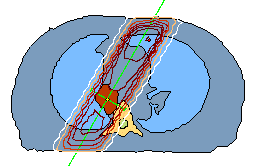The prescription dose to PTV The isodose curve representing 93% of the
prescription dose must encompass the entire planning target volume (PTV) shall be
according to the following dose escalation schema: RT - 3D treatment plan - no elective
nodal irradiation
Arms 1 and 2 -75.25 Gy/35 fx (2.15 Gy per fraction)
Arms 3 and 4 - 84 Gy/35 fx (2.4 Gy per fraction)
Arms 5 and 6 -79.5 Gy/30 fx (2.65 Gy per fraction)
Arms 7 and 8 -75 Gy/25 fx (3.0 Gy per fraction)
The percentage of total lung volume (the
volume of both lungs minus the PTV) exceeding 20 Gy (V20) shall be < 30%.
The total
volume of the esophagus shall be contoured and the PTV should NOT be subtracted from this
volume. The percentage of this esophageal volume exceeding 55 Gy (V55) shall be < 28%
and the mean esophageal dose shall be < 32 Gy. Because the dose per fraction is
increasing the V20 and V55 parameters as described above, they will need to be modified to
account for this effect in normal organs, specifically lungs and esophagus. Since this
study uses larger than standard fraction size, the V20 and V55 for lungs and esophagus
respectively should be modified as follows.
Dose per fraction
V20
becomes V55 becomes
2. 0 Gy
V20
V55
up to 2.25 (Arms 1-2)
V19
V52
2.25 to 2.5 (Arms 3-4)
V18
V50
2.5 to 2.9 (Arms 5-6)
V18
V47
> 3.0 (Arms 7-8)
V17
V44
For example, if the patient is on arm 4 where the dose per fraction is 3.0 Gy, then the
V17 for the total lung DVH must be less than 30% and the V44 for the esophagus must be
less than 28%.
The tolerance of the lungs are related to the volume of the organ(s) irradiated.
Data from the Washington University reported that high-grade acute pneumonitis did not
occur when the V20 was < approximately 30%. The incidence and the grade or severity of
pneumonitis was clearly related to the V20. In the Washington University data, maximum
dose (with conventional fractionation) was not related to acute pneumonitis. For this
protocol all eligible patients must have the V20 < 30%. The esophagus volume (outer
muscular contour) must be contoured from the level of just below the larynx to the
gastro-esophageal juncture. Oral contrast at the time of scanning is necessary to
delineate the esophagus. The percentage of the esophageal volume exceeding 55 Gy shall be
< 28% and the mean esophageal dose shall be < 32 Gy. Because of the higher dose per
fraction, the maximum spinal cord (point) dose should not exceed 35 Gy. Partial volume
tolerance data for heart is not available. The heart dose should be kept as low as
possible. Whole heart dose should not exceed 40 Gy. The liver dose should be kept to a
minimum. Half the liver should not exceed 35 Gy. The whole liver should not exceed 30 Gy.
Chemotherapy: concurrent beginning day 1 with RT
Schema A: Paclitaxel 50 mg/m2, over 1 hour, days 1, 8, 15, 22, 29, 36, 43
Followed by Carboplatin AUC=2, over 30 minutes, days 1, 8, 15, 22, 29, 36, 43
Schema B: Paclitaxel 135 mg/m2, over 3 hours, days 1, 22, 43
Followed by Carboplatin AUC=5, over 30 minutes, days 1, 22, 43 |

